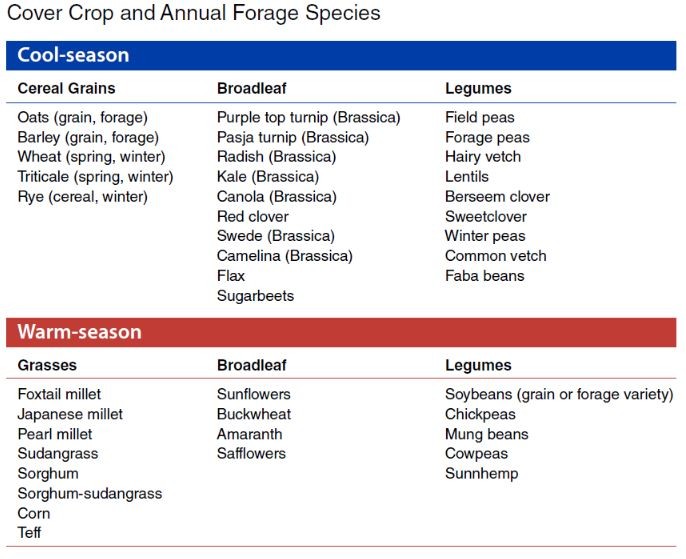Annual Cool-Season Forages for Emergency Plantings
Amy Barkley, Livestock Specialist
Southwest New York Dairy, Livestock and Field Crops Program
Annual Cool-Season Forages for Emergency Plantings
When pasture and hay fields produce sub optimally because of adverse weather, severe weed pressure, stand age, or other causes, cool season annuals can be planted as emergency measure to boost forage stores for the upcoming winter and early spring. Even if forage is readily available, this method can be used to provide high quality forage in short order.
There is a large number of cool season forages to choose from. Small grains, legumes, and brassicas are popular choices. That said, if planning to plant this year, the choices are going to be limited by the available growing season remaining, the end goal for the forage (storage vs grazing vs stockpiling), anticipated fall field conditions (dry vs wet), what animal groups are being fed, and whether you want the forage for this fall or next spring.
This annual forage table from North Dakota State University shows both warm and cool season annuals used for forage. More on cultural/planting information for these crops can be found at https://www.ag.ndsu.edu/publications/livestock/annual-cover-crop-options-for-grazing-and-haying-in-the-northern-plains

If planting annual forages around now for a fall harvest, the cutoff planting date is going to be August 15th, though this varies somewhat by species. This deadline allows enough time for the forage to accumulate enough growing degree days prior to the temperature drop we experience in September. A general rule of thumb is that at 60 days, if the weather was good, there should be a good amount of forage to harvest. If harvesting before this time to get a higher quality forage for milking herds, just say, then there will be a significant tradeoff with yield.
When looking at the best "bang for your buck" in terms of the small grains, oats are a great choice. They may not overwinter in the SWNY region, but put on quite a bit of forage mass in 60 days. It's expected that this crop will produce around 0.8 - 1.5 tons/acre, and the nutrition value will be around 20% CP and 46% NDF at a stand age of 60 - 75 days. Winter rye is a good choice as well, and while it doesn't put on as much bulk as oats in the fall, it overwinters well for a spring crop.
If thinking of stockpiling, brassicas can be a great choice because they maintain quality and palatability, even through frosts and into early winter. Sheep and beef cattle, with some prompting by the herdsperson, have been known to graze brassicas through 12" - 18" of snow.
If the plan is to harvest small grain forages in the spring, there may be an opportunity to make a fall harvest in addition to the one in the spring if crop, weather, and field conditions permit. However, keep in mind that if harvesting in the fall, a 4" stubble height should be maintained to allow for optimal green-up in the spring. Grazing may cause more damage to the plants than mechanical harvesting, especially if fields are on the wet side. In addition, it's more difficult to maintain a 4" minimum stubble height with grazing, especially if rotational grazing is not used. It is recommended that a sacrifice area for livestock be utilized once the desired grazing height is achieved and before the pasture is mature enough to graze in the spring, especially if the animals have full pasture access.
The typical fall field conditions on a farm can influence the feasibility of planting of late season annuals. If the fields get wet in the fall, it could be challenging to get equipment on there if harvesting mechanically. If harvesting by grazing, compaction and tearing up by hooves can be a concern.
All harvesting considerations aside, planting at this time of year can be a challenge. While late summer typically brings more moisture, it doesn't always. Ground with less moisture has the added challenge of not making proper seed-to-soil contact, especially if planting with a no-till drill. Small seeds are more vulnerable to this problem than larger seed, since larger seed is typically planted deeper. Small seeded crops can also be easily stressed by continued dry conditions once sprouted, whereas larger seeded crops are slightly more tolerant. Either way, if a field has proper pH and fertility, it will give the seed its best chance to get up and over potential weed challenges.
In summary, cool season annuals can be a method of making high quality forage available in about 60 days. There are challenges associated with late plantings of forage crops, but they can be overcome through management. For more information on utilizing annuals as forage, contact Amy Barkley, Livestock and Beginning Farms Specialist, at amb544@cornell.edu or (716) 640-0844.
The information shared in this document was provided by the Capital Area Agriculture and Horticulture Program Team. The complementary PowerPoint presentation can be found here.
Upcoming Events
WEBINAR - Automated Milking Systems Efficiency: Balancing Focus on Individual Cows and System Optimization
May 8, 2024
Please join Cornell the SWNY team and MSU Extension for our talk with Dr. Pablo Silva Boloña on improving efficiency of Automated milking systems by focusing on milking settings for individual and group success.
Broiler Field Day at Sunny Cove Farm
June 6, 2024
Alfred Station, NY
Join us for a field day to explore broiler production, processing, and finances. Meghan Snyder of Sunny Cove Farm will be our host. She raises small batches of organic broilers, processing them on-farm under the 1,000 bird exemption.
Stockmanship and Stewardship 2024
October 25, 2024
Hamburg, NY
Save the date!! The event is one of 4 across the US and is a two-day educational experience featuring low-stress cattle handling demonstrations, Beef Quality Assurance educational sessions, facility design sessions, and industry updates.
Announcements
No announcements at this time.





